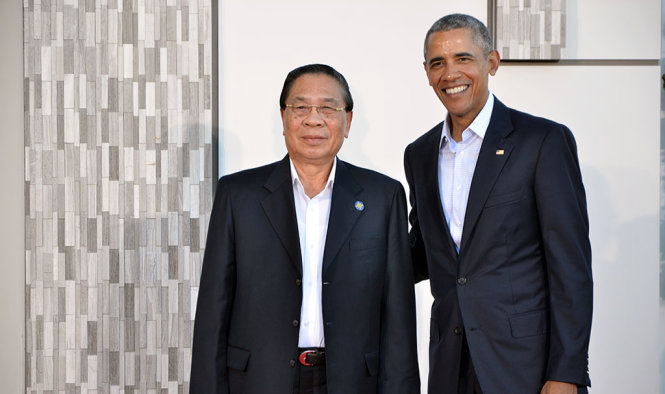On the morning of 20 August, 1973, American-trained officers of the Royal Lao Air Force returned from exile to launch a coup attempt, taking control of Vientiane’s Wattay International Airport, in a last ditch effort to exclude communists from the country’s new coalition government. By noon their leader had been shot down over the airfield, and the coup had failed. Two years later, Laos’ communist party would take full control of the country, which it has never relinquished.
The 1973 coup attempt was just one episode in a history of difficult relations between the US and the small, isolated communist state, which the US bombed heavily during the Vietnam War. Differences remain over that history, as well as over human rights, the environment, narcotics, and China’s role in the region. But next week, when Air Force One lands at Wattay, President Barack Obama will become the first US president to visit Laos.
Under normal circumstances, Laos would be an unlikely destination for an American president in the final months of his term. But Obama’s decision to visit Laos is a demonstration of his commitment to his rebalance policy, by which the US under Obama has steadily dedicated greater money, time, and effort to the Asia Pacific.
The economic and military efforts of the rebalance have been the subject of much discussion. The Trans-Pacific Partnership trade agreement has been sent to Congress for approval, and the Department of Defense continues to rotate an increased share of its resources through the region, where the US military is better integrated with its allies than it has been in decades, and has established new relationships with former adversaries. Increased economic and military engagement in the region is meant to provide ballast, keeping the region stable and peaceful, as power shifts to the region and within the region.
Less understood has been the diplomatic plank of the rebalance.
As Nina Silove noted in a recent article in International Security, some of the economic and military efforts were initially nurtured in the Bush Administration, even if they only grew to maturity under Obama. But it has been the Obama Administration’s diplomatic efforts which have distinguished the rebalance. This is true of US engagement with individual governments (like Laos) but it is especially the case for US engagement in multilateral forums of the region, like the East Asia Summit that Obama will attend Tuesday and Wednesday next week.
When the Obama Administration came into office, the US was perceived to be ambivalent about exercising diplomatic leadership in the region. President Bush attended the annual Asia-Pacific Economic Cooperation forum, though it was limited in scope to little more than economic issues, and had been in decline as a serious vehicle for economic liberalisation since well before he took office. It should also be noted that Bush’s second-term assistant secretary of state for East Asia and Pacific affairs, Chris Hill, spent much of his four years in office working through the Six-Party Talks to seek the denuclearisation of the Korean Peninsula.
But the Bush Administration neglected diplomacy with Southeast Asia and the Association of Southeast Asian Nations (ASEAN). Bush’s second-term Secretary of State Condoleezza Rice twice skipped the ASEAN Regional Forum, in 2005 and 2007. Rice considered the forum little more than a talk shop, and was seeking to protest ASEAN’s failure to place more pressure on Myanmar’s junta to democratise.
Southeast Asian diplomats considered the no-shows a sign of disengagement. As Hillary Clinton would note on her first trip to Asia as Rice’s successor, channeling Woody Allen: ‘Showing up is not all of life — but it counts for a lot.’
The Bush Administration also kept its distance from the East Asia Summit (EAS), organised by ASEAN. The summit was launched in 2004 to serve as the first meeting of all the region’s key leaders with a remit to discuss a broad range of issues, including security. Bush Administration officials argued that it would be difficult to schedule a presidential trip to Asia for another summit each year in addition to APEC, and that it was not yet clear the summit would be a useful forum for discussing sensitive issues.
The Obama Administration reasoned that if it were committed to the region, it could manage these challenges. In the end, APEC and the EAS have been scheduled sequentially so as to facilitate the president’s travel; and as soon as the US joined in 2011, the forum began to take on difficult issues like tensions in the South China Sea.
Bush’s preference for coalitions of the willing and distaste for engagement with dictatorial anti-American regimes gave way to the Obama Administration’s inaugural promise to ‘extend a hand if you will unclench your fist.’ Obama convened the first US-ASEAN Leaders’ Meeting in Singapore in 2009, despite the presence of General Thein Sein as a representative of Myanmar’s junta (a move the Bush Administration would not countenance). Two years later, Thein Sein would become president and (for reasons that are still not fully apparent) move Myanmar toward democracy.
These changes matter. Under Bush, American diplomatic engagement appeared ad hoc, limited to issues of interest to Washington, and to countries of Washington’s choosing. The rebalance flipped the script, meeting Southeast Asian leaders on their home ground, in a format and setting of their creation. It represented a fuller commitment to diplomacy in the region, and to the norms and institutions of the liberal international order. And it ensured that the US would be in the room when those norms are debated or revised.
As Mike Fuchs wrote in the New Republic this week, the ‘real work of diplomacy – establishing relationships, building trust, opening channels of communication between governments – does not often make the headlines.’ But as President Obama prepares to make his last trip to a region that he has visited more than any of his predecessors, the success of the diplomatic elements of the rebalance deserve our attention.
Source: The Interpreter



